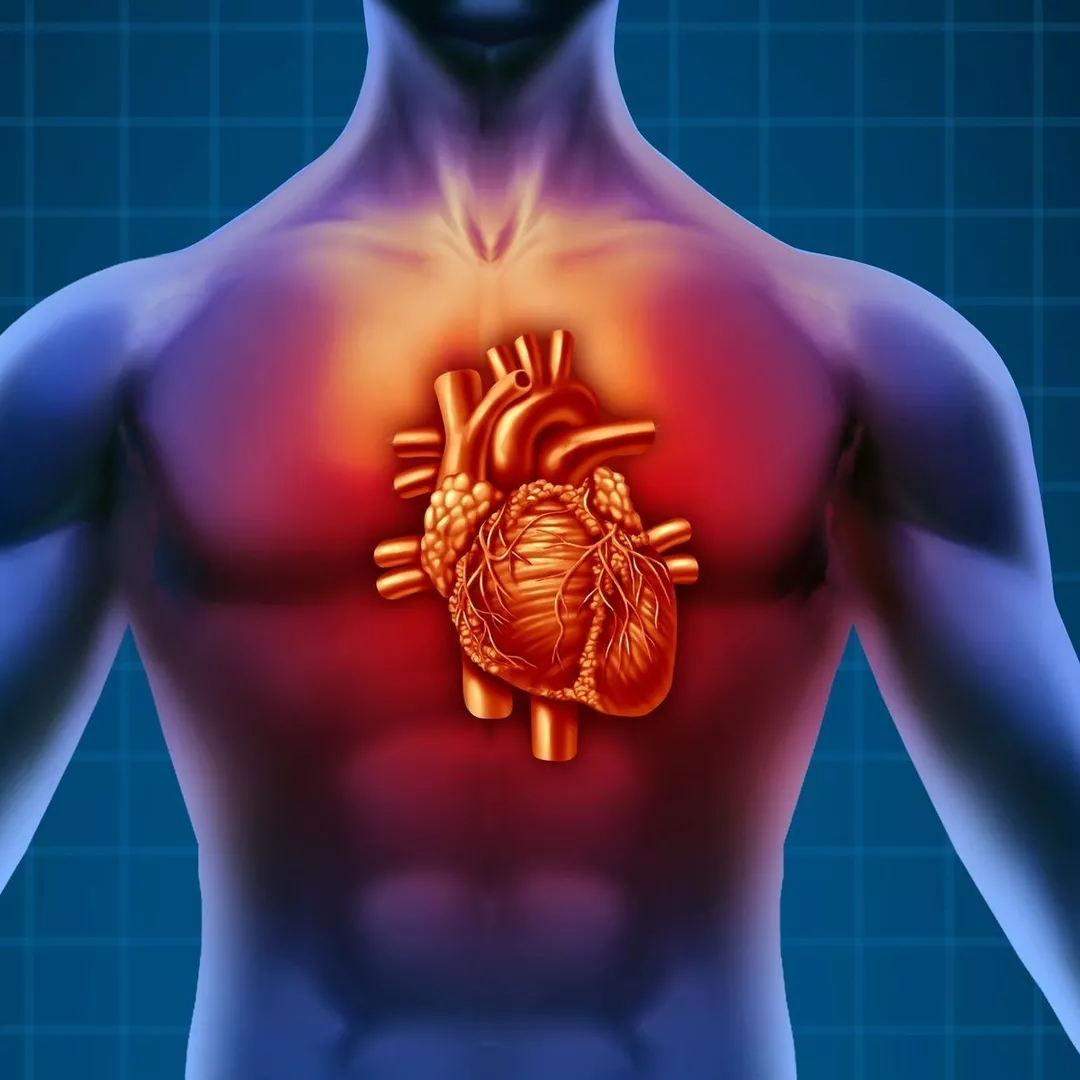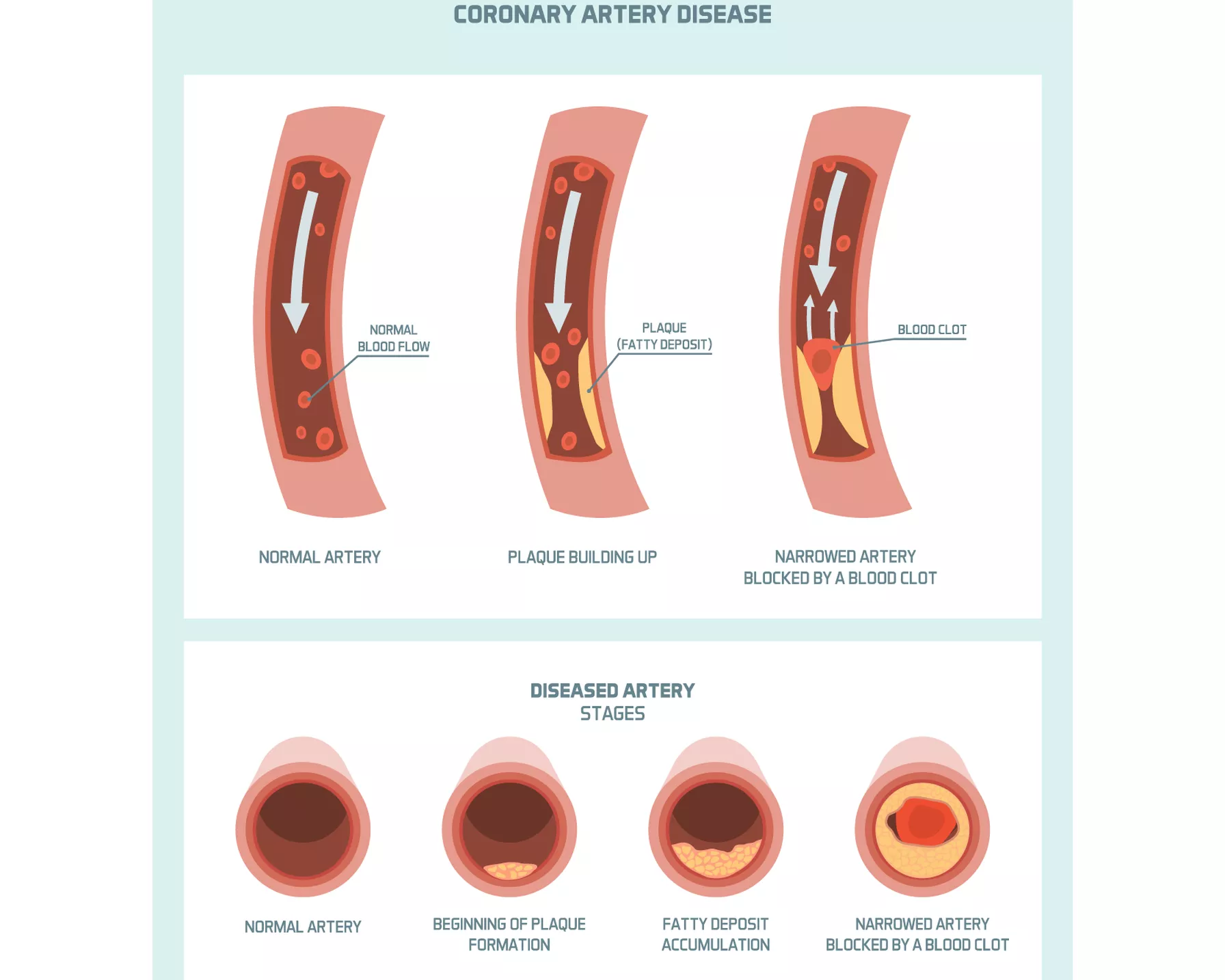What is a heart attack?
A heart attack occurs when the heart is deprived of oxygen due to a blockage in one of the coronary arteries that supplies blood to the heart. Heart attack is also known as a myocardial infarction (MI).
The heart is one of the most important muscles in the body, and a heart attack can lead to death. This is because the heart pumps blood that carries oxygen needed for survival all around the body through the circulatory system.
The heart needs a continuous supply of oxygen-rich blood to work properly. The left side of the heart receives oxygen-rich blood from the lungs and pumps it to the rest of the body. The right side receives deoxygenated blood that it then sends to the lungs, where the blood picks up oxygen and offloads carbon dioxide.
In a heart attack where a coronary artery is blocked, the blood flow to the heart is stopped, reducing the amount of oxygen that the heart receives. The longer that the blockage remains untreated, the greater the damage to the heart. Without oxygen, the heart muscle can start to die, and without treatment to restore blood flow, the heart can be permanently damaged.
Blocked arteries could lead to heart attack. Without oxygen, the heart muscle can start to die, and the longer that the blockage remains untreated, the greater the damage to the heart. Image: iStock
The main causes of heart attack
The most common cause of heart attack is coronary heart disease, or coronary artery disease, where the blood vessels that supply blood to the heart are blocked.
Blockages can occur when fat, cholesterol and other substances build up and form a plaque in the arteries, in a process known as atherosclerosis. Over time the plaque can grow bigger, which can narrow the artery and cause it to stiffen. This reduces blood flow to the heart, and with this decreased blood supply, the heart is starved of the vital oxygen it needs to function properly.
There are two types of plaque – stable and unstable. Stable plaques can lead to a narrowing of the opening of the arteries over time, which can obstruct and restrict blood flow to the heart. In contrast, unstable plaques are prone to rupture even before they are large enough to obstruct blood flow. Unstable plaques are potentially dangerous because they can cause a sudden blockage without warning. This can happen at any age.
If the plaque breaks away from the artery wall, it can form a clot that interrupts the flow of blood carrying oxygen throughout the body. If a clot blocks or stops blood flow to the heart, a heart attack can occur, and the heart muscle starts to die.
The coronary artery can be completely blocked or partially blocked, and the diagnosis and treatment options may differ according to the type experienced. A complete blockage is called an ST elevation myocardial infarction (STEMI), and a partial blockage is called a non-ST elevation myocardial infarction (NSTEMI).
Other causes of heart attack include coronary artery spasms. If a coronary artery has a spasm, this can reduce or stop blood flow to the heart. If the spasm is severe enough, it can cause a heart attack. Coronary artery spasms can occur due to the use of illicit substances.
COVID-19 infection can also cause blood clots that can damage the heart and lead to a heart attack.
The most common cause of heart attack is coronary artery disease, where the blood vessels that supply blood to the heart are blocked. Image: iStock
The most common symptoms of heart attack in men and women
It’s important to be aware of the most common symptoms of heart attack and seek medical help immediately if you, or someone you know, is experiencing symptoms. Early treatment is vital and could mean the difference between life and death.
People may experience one or a combination of symptoms, and symptoms can also differ between men and women. The most common symptoms of a heart attack are:
- chest pain, pressure or an aching sensation in the chest or arms that can spread to the neck, jaw or back
- shortness of breath or breathing difficulties
- nausea or vomiting
- heartburn, indigestion or abdominal pain
- light-headedness or sudden dizziness
- feeling faint or anxious
- cold sweats
- fatigue.
Heart attack symptoms: women
Heart disease and heart attacks are often associated with men, but heart disease affects women just as much. While women may experience the same symptoms of heart attack, the chest pain most commonly felt by men may not be as severe or noticeable. It is also possible to have a heart attack without chest pain. Women are more likely to experience symptoms of heart attack unrelated to chest pain, such as:
- discomfort in the neck, jaw, shoulder, upper back or abdomen
- breathlessness and a general feeling of unwellness
- pain, tightness or discomfort in one or both arms
- nausea or vomiting
- heartburn or indigestion
- sweating
- light-headedness or dizziness
- unusual fatigue.
Women tend to have heart attack symptoms more often when resting, or even when asleep, compared to men. Stress can also trigger heart attack symptoms in women.
While heart attacks can be sudden, some people experience symptoms and warning signs hours or even days in advance, such as recurrent chest pain or pressure. A heart attack can only be diagnosed by medical tests. It is important to seek medical help immediately if you suspect a heart attack.
Main heart attack risk factors
The underlying cause of a heart attack is atherosclerosis. Atherosclerosis can display no symptoms, but there are risk factors that increase your chance of developing it.
Certain risk factors cannot be changed, so it’s important to keep an eye on your heart health if you meet any of these factors.
- Age: Your risk of heart disease increases with age. Men aged 45 years and over and women aged 55 years and older have a greater risk than younger men and women.
- Gender: Men are at a higher risk of heart attack, but women are more likely to die from a repeat heart attack than men.
- Ethnicity: Some ethnicities have a higher risk, including.
- Family history: If a family member has had a heart attack, you may be at increased risk. This appears to be a greater risk factor in women than in men.
However, other risk factors related to lifestyle can be changed or managed.
- Smoking: Both first-hand smoking and long-term exposure to second-hand smoke can damage arteries that supply blood to your heart and body.
- High blood pressure: Over time, this can damage the arteries leading to the heart and place strain on the heart.
- High cholesterol: High levels of the “bad” cholesterol (LDL cholesterol) can narrow the arteries and increase the risk of developing cardiovascular disease.
- Unhealthy weight: Being overweight or obese is linked to other risk factors like high blood pressure and high cholesterol, and increases your chance of having a heart attack.
- Diabetes: People living with diabetes are over twice as likely to develop cardiovascular disease and up to four times more likely to suffer a heart attack.
- Inactivity: Lack of physical activity can contribute to being an unhealthy weight and increase the risk of high blood pressure and cholesterol levels.
Visit the risk factors page for more information.
How to reduce heart attack risk
An important step in reducing your heart attack risk is to get on top of your heart health and speak to your doctor about having an annual heart health check. This may involve discussing your family history then measuring your blood pressure, blood sugar and total cholesterol levels. Unhealthy levels of these can increase your risk of heart conditions and heart attack, but they may not show any visible symptoms.
Making positive lifestyle changes to decrease your risk factors is another key step in reducing the risk of heart attack. Even small changes can have a positive impact on your risk. These can include maintaining a healthy weight through a heart-healthy diet and lowering alcohol intake, exercising regularly, quitting smoking and taking steps to manage blood pressure levels as well as to lower cholesterol levels. Speak to your doctor about what changes you can make.
Reduce your risk of heart attack and cardiovascular disease by making positive lifestyle changes like being more active and eating a healthier diet. Images: Pexels
Heart attack treatment
Emergency treatment to quickly restore blood flow to the heart is vital. The longer the heart is deprived of oxygen, the greater and more permanent the damage to the heart. Treatment for heart attack may involve medications or surgery, and medical research over the years has helped to improve treatment options and survival rates.
To treat heart attack, medicines called thrombolytics are often used to dissolve the blood clot blocking blood flow to the heart. Medications may also be prescribed to help reduce the risk of another heart attack. These can include:
- blood-thinning medications such as aspirin, to prevent clots from forming and stop existing clots from growing
- blood pressure medications to lower blood pressure and reduce the strain on the heart
- beta blockers to help relax the heart muscle and decrease the heart rate, to reduce the load on the heart and the risk of a heart attack.
In more severe cases, surgery may be required to restore blood flow to the heart. Surgical procedures include coronary angioplasty and coronary artery bypass graft surgery (CABG).
In a coronary angioplasty, the narrowed artery is widened from the inside by using a special device that is inserted through the groin or wrist and then guided into the artery. A small mesh tube (stent) may be inserted and left inside the artery to keep it open.
In a CABG, a healthy blood vessel is taken from the body and grafted to each side of the blocked artery to redirect blood around (bypass) the blockage and improve blood flow to the heart.
Recovering from a heart attack
Suffering a heart attack can be a terrifying and life-changing experience, and the recovery process can be both emotionally and physically challenging. Having one heart attack also increases your risk of having another, but this can be greatly reduced with the correct management and treatment.
Recovery can take several months, and it’s important not to rush the process. Your healthcare team will work with you on your recovery and assist you to return to your everyday activities, such as returning to exercise. Cardiac rehabilitation is also a vital part of your treatment and can enable you to return to a full and active life.
How is HRI fighting heart attack?
HRI is conducting innovative research to develop new therapies for detecting, preventing and treating heart attacks.
Our Coronary Diseases Group is investigating whether the anti-inflammatory drug colchicine, which has already proved safe and effective for treating conditions like arthritis and gout, can be repurposed to protect against repeat heart attacks. A collaboration between the Coronary Disease Group and our Clinical Research Group has also discovered that the heart releases certain substances during a heart attack that can be detected in the laboratory.







